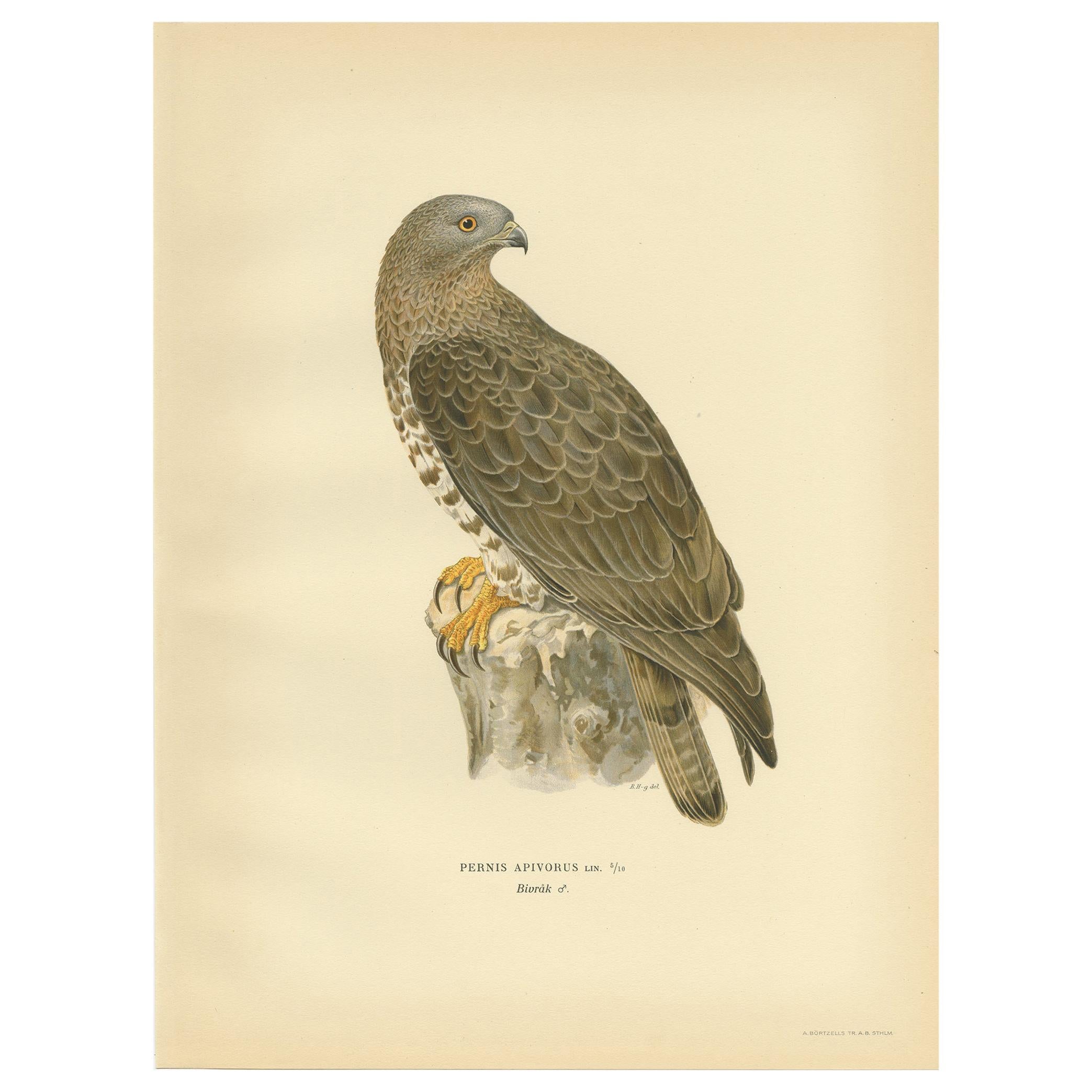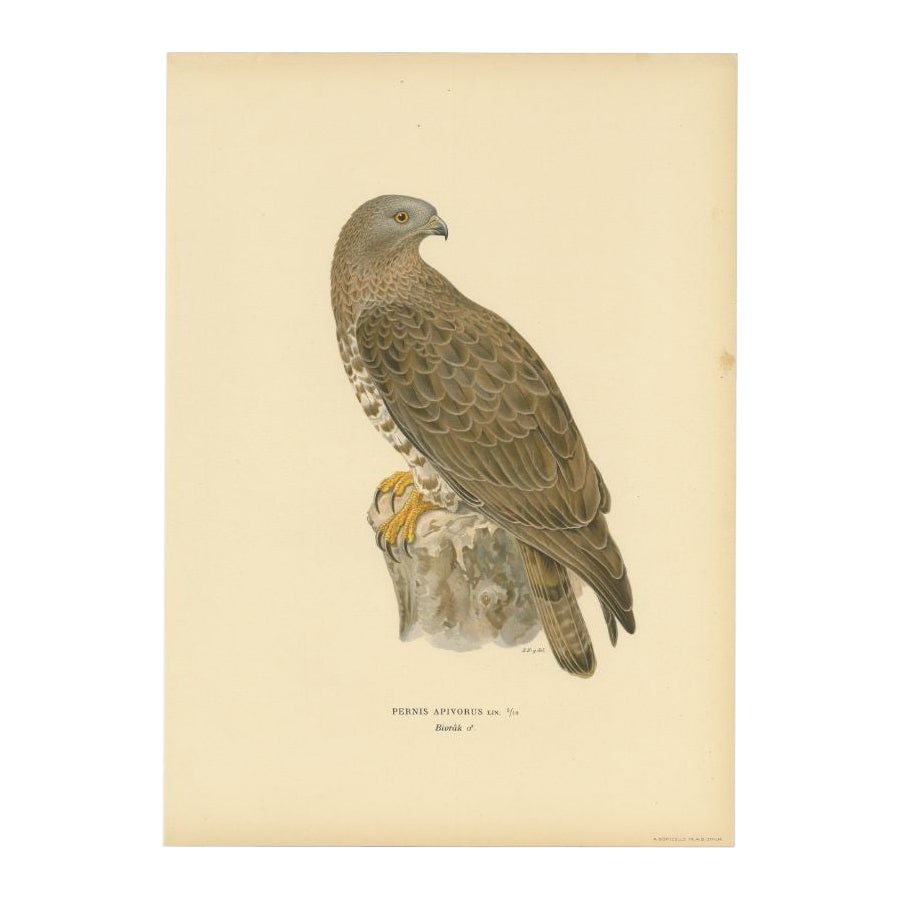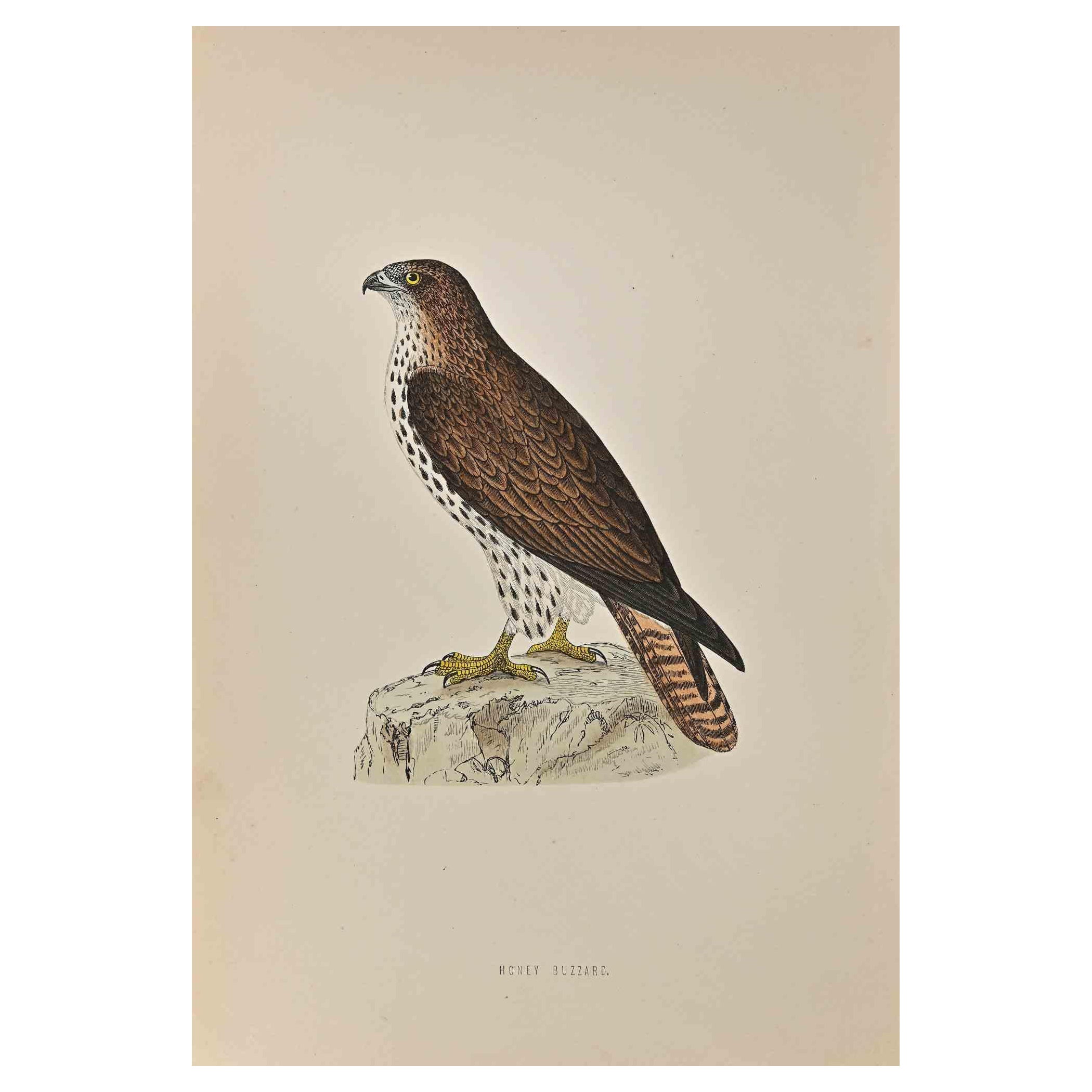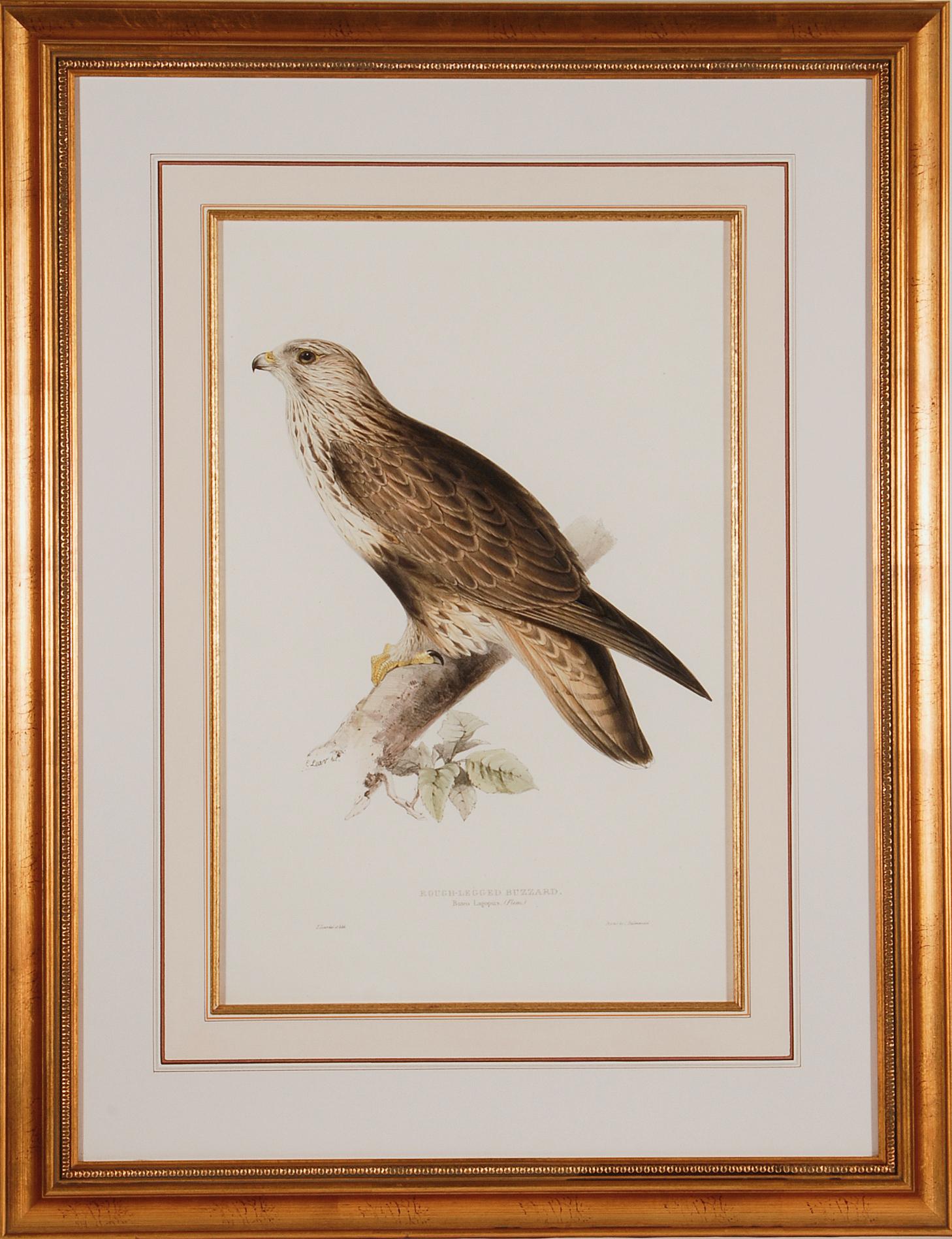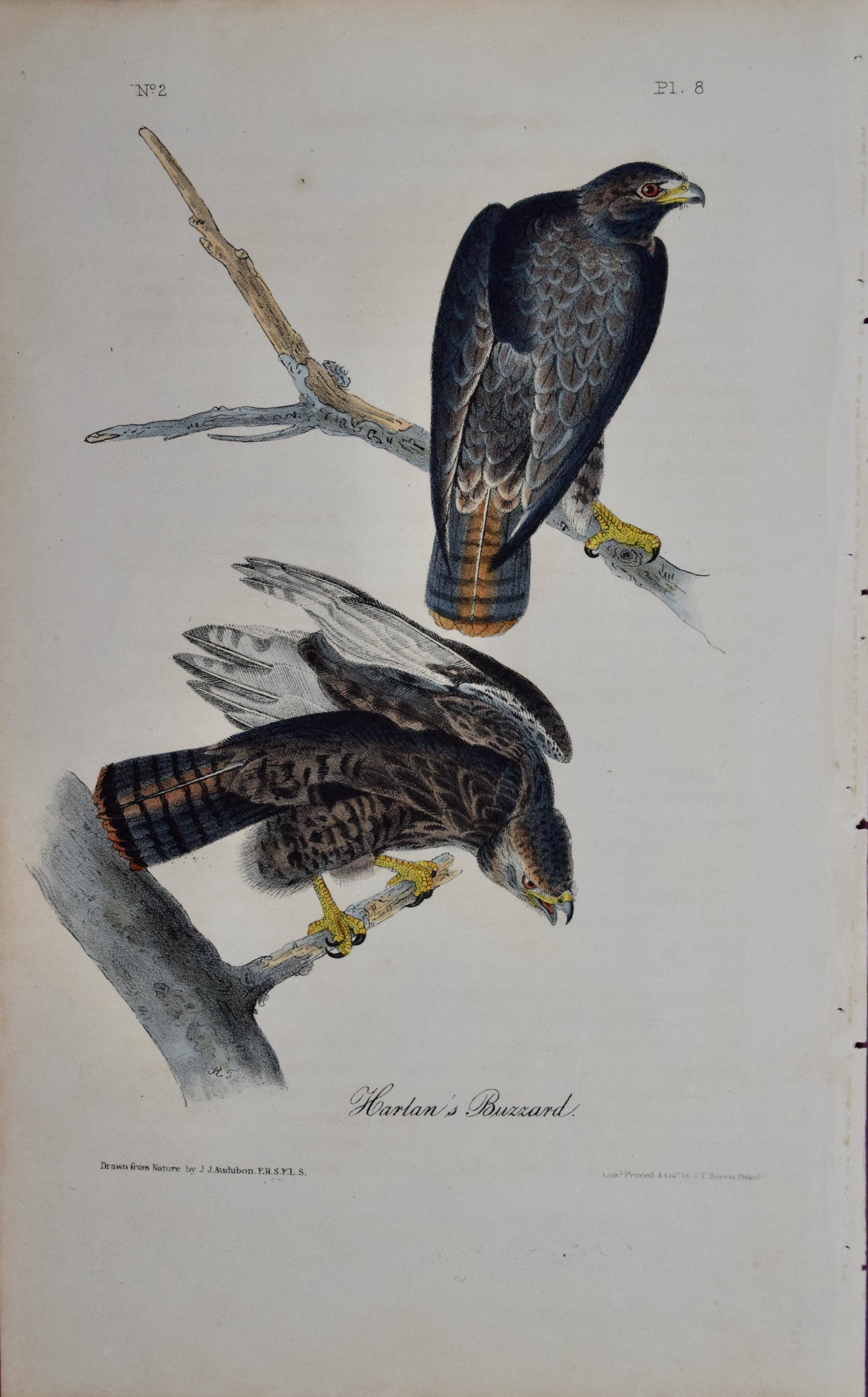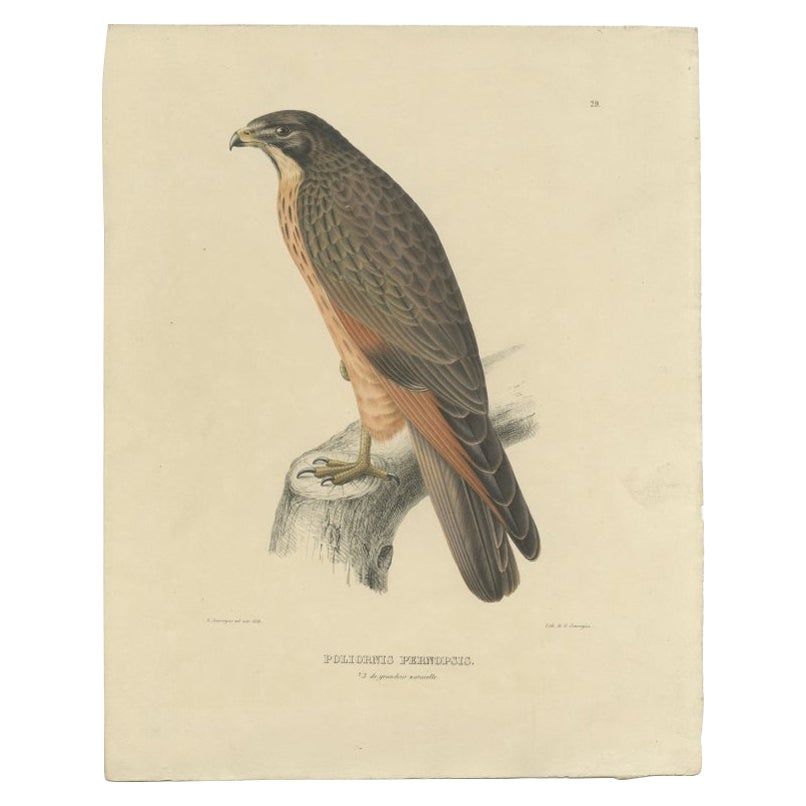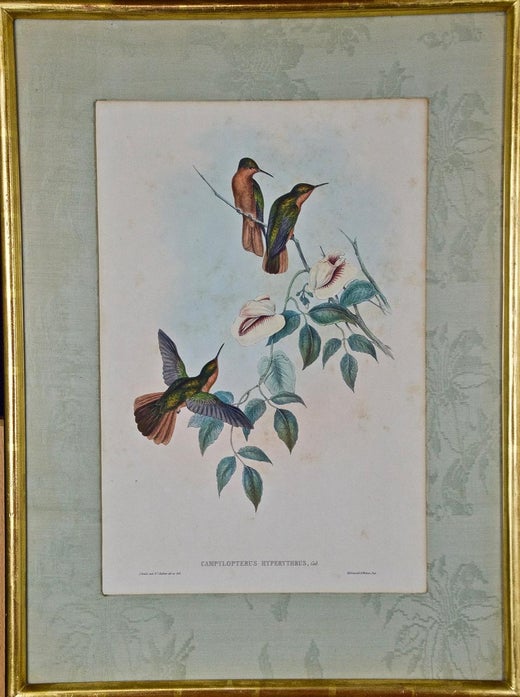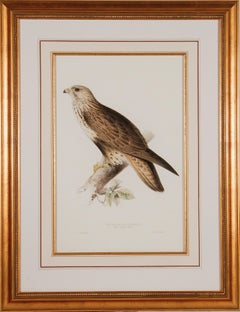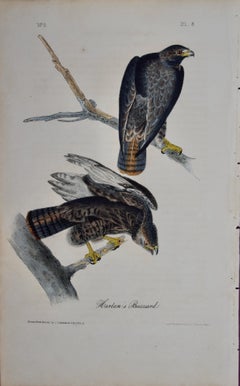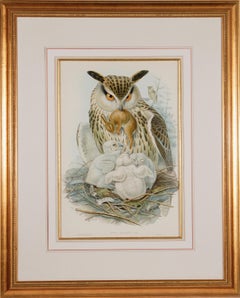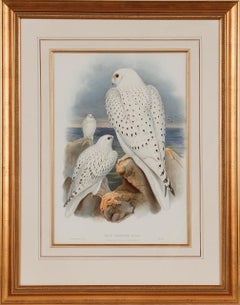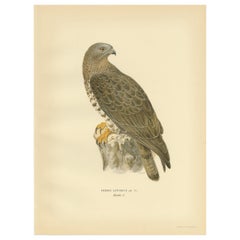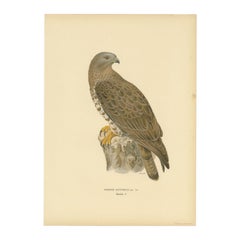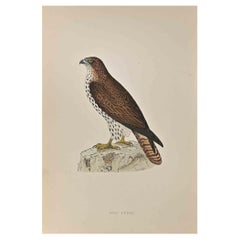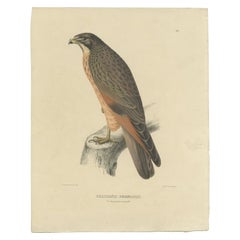Items Similar to Honey Buzzard Bird: A Framed Original 19th C. Hand-colored Lithograph by Gould
Want more images or videos?
Request additional images or videos from the seller
1 of 10
John Gould and Henry Constantine RichterHoney Buzzard Bird: A Framed Original 19th C. Hand-colored Lithograph by Gould1862-1873
1862-1873
$2,860
$3,57520% Off
£2,205.48
£2,756.8520% Off
€2,514.91
€3,143.6420% Off
CA$4,078.95
CA$5,098.6920% Off
A$4,457.82
A$5,572.2820% Off
CHF 2,345.85
CHF 2,932.3120% Off
MX$53,393.66
MX$66,742.0820% Off
NOK 29,524.86
NOK 36,906.0720% Off
SEK 27,575.07
SEK 34,468.8320% Off
DKK 18,784.08
DKK 23,480.0920% Off
About the Item
This is a framed original 19th century hand-colored folio-sized lithograph entitled “Pernis Apivorus (The Honey Buzzard) by John Gould, plate 6 in volume 1 of his "Birds of Great Britain", published in London between 1862 and 1873. The print depicts an adult Honey Buzzard perched on a branch of a leafy tree in the foreground and three others in the background. The bird in the foreground has an insect in its beak and others are in flight on the right
This striking framed Gould hand-colored lithograph is presented in an ornate gold-colored wood frame, a gold-colored fillet and a cream-colored French mat with a prominent ecru-colored band and a thinner mauve band. The frame measures 35" high, 28.25" wide and 1.5." thick. The descriptive text page from the original 19th century publication is included and is housed in a mylar sleeve attached to the back of the frame. The print and frame are in excellent condition
There are several other framed and unframed Gould bird lithographs available on our 1stdibs and InCollect storefronts. Two or more of these striking lithographs would make an attractive display grouping. A discount is available for purchase of a set depending on the number. These additional Gould hummingbirds may be viewed by typing Timeless Intaglio in the 1stdibs search field and tapping on the drop down name to be taken to our storefront or at InCollect.
John Gould (1804-1881]) was an English ornithologist and artist. He, like his American contemporary John James Audubon, published a number of books on birds in the mid 19th century, illustrated by hand-colored lithographs. His wife and fellow artist, Elizabeth Gould, and several other artists including Edward Lear and Henry Constantine Richter produced lithographs for his various publications. He has been considered the father of bird study in Australia and the Gould League in Australia is named after him. Charles Darwin referenced Gould’s work in his book, "On the Origin of Species" and Gould named a bird after Darwin; "Darwin's finches".
Gould began his career in London as a taxidermist, but in 1827 became the first curator and conservator at the museum of the Zoological Society of London. In this position naturalists brought him collections of birds from all over the world. He began creating drawings and eventually hand-colored lithographs with his wife and Edward Lear, which were the basis for his first publications. Darwin brought him specimens from the Galapagos Islands, including 12 species of finches which had never been described. In 1838, Gould and his wife travelled to Australia and their work led to the seven volume publication of “The Birds of Australia”. Gould had a fascination for hummingbirds and collected specimens of 320 varieties before ever seeing a live hummingbird on a trip to the United States in 1857. He eventually published “A Monograph of the Trochilidae, or Family of Humming-birds". Other large publications include: "The Birds of Europe"," A Monograph of the Ramphastidae, or Family of Toucans”, “A Synopsis of the Birds of Australia, and the Adjacent Islands”, “A Monograph of the Odontophorinae, or Partridges of America”, “The Birds of Asia”, “The Birds of Great Britain” and "The Birds of New Guinea and the Adjacent Papuan Islands, including many new species recently discovered in Australia".
John Gould (1804-1881) was a British ornithologist and illustrator who is best known for his monumental work, "The Birds of Europe," published between 1832 and 1837. Gould was born in Lyme Regis, Dorset, England, and began working as a taxidermist and natural history dealer in London in the 1820s. In 1827, Gould was appointed the first curator and preserver of birds at the Zoological Society of London, where he began to build his collection of specimens and began to study the birds of the world. He published his first monograph, "A Century of Birds from the Himalaya Mountains," in 1831, which included 80 plates of Himalayan birds. Gould continued to publish numerous volumes on the birds of the world throughout his life, including "The Birds of Australia" (1840-1848) and "The Birds of Great Britain" (1862-1873). His works were highly regarded for their accuracy and detail, and he was one of the most prominent ornithologists of his time.
In addition to his work as an ornithologist, Gould was also a successful businessman, and he used his profits to fund expeditions and to support the scientific community. He was elected a Fellow of the Royal Society in 1843, and he was awarded the Royal Medal in 1844 and the Gold Medal of the Zoological Society in 1856. John Gould died in London in 1881 at the age of 76. He is remembered as one of the greatest ornithologists of the 19th century and as a pioneer of the scientific study of birds.
- Creator:John Gould and Henry Constantine Richter (1804 - 1881, English)
- Creation Year:1862-1873
- Dimensions:Height: 35 in (88.9 cm)Width: 28.25 in (71.76 cm)Depth: 1.5 in (3.81 cm)
- Medium:
- Movement & Style:
- Period:
- Condition:
- Gallery Location:Alamo, CA
- Reference Number:Seller: # 52191stDibs: LU1173212687672
John Gould and Henry Constantine Richter
John Gould (1804-1881]) was an English ornithologist and artist. He, like his American contemporary John James Audubon, published a number of books on birds in the mid 19th century, illustrated by hand-colored lithographs. His wife and fellow artist, Elizabeth Gould, and several other artists including Edward Lear and Henry Constantine Richter produced lithographs for his various publications. He has been considered the father of bird study in Australia and the Gould League in Australia is named after him. Charles Darwin referenced Gould’s work in his book, "On the Origin of Species" and Gould named a bird after Darwin; "Darwin's finches". Gould began his career in London as a taxidermist, but in 1827 became the first curator and conservator at the museum of the Zoological Society of London. In this position naturalists brought him collections of birds from all over the world. He began creating drawings and eventually hand-colored lithographs with his wife and Edward Lear, which were the basis for his first publications. Darwin brought him specimens from the Galapagos Islands, including 12 species of finches which had never been described. In 1838, Gould and his wife travelled to Australia and their work led to the seven volume publication of “The Birds of Australia”. Gould had a fascination for hummingbirds and collected specimens of 320 varieties before ever seeing a live hummingbird on a trip to the United States in 1857. He eventually published “A Monograph of the Trochilidae, or Family of Humming-birds". Other large publications include: "The Birds of Europe"," A Monograph of the Ramphastidae, or Family of Toucans”, “A Synopsis of the Birds of Australia, and the Adjacent Islands”, “A Monograph of the Odontophorinae, or Partridges of America”, “The Birds of Asia”, “The Birds of Great Britain” and "The Birds of New Guinea and the Adjacent Papuan Islands, including many new species recently discovered in Australia".
About the Seller
5.0
Platinum Seller
Premium sellers with a 4.7+ rating and 24-hour response times
Established in 2011
1stDibs seller since 2019
298 sales on 1stDibs
Typical response time: 1 hour
- ShippingRetrieving quote...Shipping from: Alamo, CA
- Return Policy
More From This Seller
View AllRough-legged Buzzard: 19th C. Hand-colored Lithograph by J. Gould & Edward Lear
By Edward Lear
Located in Alamo, CA
This is an original 19th century hand-colored folio-sized lithograph entitled "Archibuteo Lagopus" (Rough-Legged Buzzard) by John Gould and Edward Lear, from Gould's "Birds of Great Britain", published in London between 1862 and 1873. The print depicts an adult Rough-Legged Buzzard perched on a branch of a tree looking to the left.
This beautiful framed Gould hand-colored lithograph is presented in a gold-colored wood frame and cream-colored French mat, embellished by a gold-colored fillet. The frame measures 33" high, 25.5" wide and 1.25" thick. It is in excellent condition
There are several other unframed Gould bird lithographs available on our 1stdibs and InCollect storefronts. Two or more of these striking lithographs would make an attractive display grouping. A discount is available for purchase of a set depending on the number. These additional Gould hummingbirds may be viewed by typing Timeless Intaglio in the 1stdibs or InCollect search field to be taken to our storefront.
John Gould (1804-1881]) was an English ornithologist and artist. He, like his American contemporary John James Audubon, published a number of books on birds in the mid 19th century, illustrated by hand-colored lithographs. His wife and fellow artist, Elizabeth Gould, and several other artists including Edward Lear and Henry Constantine Richter produced lithographs for his various publications. He has been considered the father of bird study in Australia and the Gould League in Australia is named after him. Charles Darwin referenced Gould’s work in his book, "On the Origin of Species" and Gould named a bird after Darwin; "Darwin's finches".
Gould began his career in London as a taxidermist, but in 1827 became the first curator and conservator at the museum of the Zoological Society of London. In this position naturalists brought him collections of birds from all over the world. He began creating drawings and eventually hand-colored lithographs with his wife and Edward Lear, which were the basis for his first publications. Darwin brought him specimens from the Galapagos Islands, including 12 species of finches which had never been described. In 1838, Gould and his wife travelled to Australia and their work led to the seven volume publication of “The Birds of Australia”. Gould had a fascination for hummingbirds and collected specimens of 320 varieties before ever seeing a live hummingbird on a trip to the United States in 1857. He eventually published “A Monograph of the Trochilidae, or Family of Humming-birds". Other large publications include: "The Birds of Europe"," A Monograph of the Ramphastidae, or Family of Toucans”, “A Synopsis of the Birds of Australia, and the Adjacent Islands”, “A Monograph of the Odontophorinae, or Partridges of America”, “The Birds of Asia”, “The Birds of Great Britain” and "The Birds of New Guinea and the Adjacent Papuan Islands, including many new species recently discovered in Australia".
John Gould (1804-1881) was a British ornithologist and illustrator who is best known for his monumental work, "The Birds of Europe," published between 1832 and 1837. Gould was born in Lyme Regis, Dorset, England, and began working as a taxidermist and natural history dealer in London in the 1820s. In 1827, Gould was appointed the first curator and preserver of birds at the Zoological Society of London, where he began to build his collection of specimens and began to study the birds of the world. He published his first monograph, "A Century of Birds from the Himalaya Mountains," in 1831, which included 80 plates of Himalayan birds. Gould continued to publish numerous volumes on the birds of the world throughout his life, including "The Birds of Australia" (1840-1848) and "The Birds of Great Britain" (1862-1873). His works were highly regarded for their accuracy and detail, and he was one of the most prominent ornithologists of his time.
In addition to his work as an ornithologist, Gould was also a successful businessman, and he used his profits to fund expeditions and to support the scientific community. He was elected a Fellow of the Royal Society in 1843, and he was awarded the Royal Medal...
Category
Mid-19th Century Naturalistic Animal Prints
Materials
Lithograph
Harlan's Buzzard Birds: An Original 19th C. Audubon Hand-colored Bird Lithograph
By John James Audubon
Located in Alamo, CA
This is an original 1st edition John James Audubon hand-colored lithograph entitled "Harlan's Buzzard", No. 2, Plate 8 from Audubon's "Birds of America, lithographed, printed and col...
Category
Late 19th Century Naturalistic Animal Prints
Materials
Lithograph
Eagle or Horned Owl: A Framed Original 19th C. Hand-colored Lithograph by Gould
By John Gould and Henry Constantine Richter
Located in Alamo, CA
This is a framed original 19th century hand-colored folio-sized lithograph entitled “Bubo Maximus" (Great Horned or Eagle Owl) by John Gould, from the supplement to his "Birds of Great Britain", published in London between 1862 and 1873. The print depicts an adult Eagle Owl about to feed her brood of babies who are in the their nest. A another adult (possibly the male) is seen in the distant background in the upper right.
This striking framed Gould...
Category
Mid-19th Century Naturalistic Animal Prints
Materials
Lithograph
Greenland Falcon "Falco Candicans": A 19th C. Hand-colored Lithograph by Gould
By John Gould and Henry Constantine Richter
Located in Alamo, CA
This is an original 19th century hand-colored folio-sized lithograph entitled "Falco Candicans" (Greenland Falcon Light) by John Gould, from his "Birds of Great Britain", published i...
Category
Mid-19th Century Naturalistic Animal Prints
Materials
Lithograph
Bird of Prey: An 18th Century Hand-colored Bird Engraving by Martinet
By François Nicolas Martinet
Located in Alamo, CA
This is a hand-colored engraving of a parrot bird entitled "La Bondree (Bird of Prey)" by Francois Nicolas Martinet, plate 420 from 'Histoire Naturelle des Oiseaux' in association wi...
Category
1760s Naturalistic Animal Prints
Materials
Engraving
Golden Eagle: An Original 19th C. Audubon Hand-colored Bird Lithograph
By John James Audubon
Located in Alamo, CA
This is an original John James Audubon hand-colored lithograph entitled "Golden Eagle", No. 3, Plate 12 from Audubon's "Birds of America, lithographed, printed and colored by JT Bowe...
Category
Late 19th Century Naturalistic Animal Prints
Materials
Lithograph
You May Also Like
Antique Bird Print of the Honey Buzzard by Von Wright, 1929
Located in Langweer, NL
Antique bird print titled 'Pernis Apivorus'. Old bird print depicting the honey buzzard. This print originates from 'Svenska Foglar Efter Naturen Och Pa Stenritade' by Magnus von Wri...
Category
Early 20th Century Prints
Materials
Paper
Antique Bird Print of the Honey Buzzard, 1929
Located in Langweer, NL
Antique bird print titled 'Pernis Apivorus'. Old bird print depicting the honey buzzard. This print originates from 'Svenska Foglar Efter Naturen Och Pa Stenritade' by Magnus von Wright.
Artists and Engravers: Printed in Stockholm. Magnus von Wright (1805 - 68) was the first taxidermist working with the vertebrate collections of Helsinki University. Starting out as a taxidermist in the 1820's, he stuffed birds for Societas pro Flora et Fauna Fennica, the oldest scientific society in Finland, and in 1845, became taxidermist at the university's zoological museum. Von Wright made several study journeys to Stockholm and St. Petersburg, and even wrote a short manual on how mount birds. Though a skilful taxidermist, his reputation, like that of his two brothers, Wilhelm and Ferdinand, rests on his skill as a zoological illustrator. In 1859 he published the first handbook on Finnish birds...
Category
20th Century Prints
Materials
Paper
$160 Sale Price
20% Off
Honey Buzzard - Woodcut Print by Alexander Francis Lydon - 1870
Located in Roma, IT
Honey Buzzard is a modern artwork realized in 1870 by the British artist Alexander Francis Lydon (1836-1917) .
Woodcut print, hand colored, published by London, Bell & Sons, 1870....
Category
1870s Modern Figurative Prints
Materials
Woodcut
Antique Bird Print of the Grasshopper Buzzard by Severeyns, c.1850
Located in Langweer, NL
Antique bird print titled 'Poliornis Pernopsis'. Rare antique print of the grasshopper buzzard. Published by G. Severeyns, circa 1850.
Artists and Engravers: Guillaume Severeyns ...
Category
Antique 19th Century Prints
Materials
Paper
$246 Sale Price
20% Off
Northern Goshawk – Astur gentilis – Original 1917 Lithograph in Matting Board
Located in Langweer, NL
Northern Goshawk – Astur gentilis – Original 1917 Lithograph from "Skandinaviens Fåglar"
Original antique bird print of the Northern Goshawk (Astur gentilis), identified in Swedish as Dufalk, ung fågel, ♂ (young male goshawk). This plate originates from the 1917 edition of Skandinaviens Fåglar (Birds of Scandinavia), published by Albert Bonniers Förlag in Stockholm. The work was one of the most beautifully illustrated ornithological publications of the early 20th century and features plates after illustrations by the famous wildlife artists William von Wright and Bruno Liljefors...
Category
Early 20th Century Swedish Prints
Materials
Paper
Antique Bird Print of the Grasshopper Buzzard by Severeyns 'c.1850'
Located in Langweer, NL
Antique bird print titled 'Poliornis Pernopsis'. Rare antique print of the grasshopper buzzard. Published by G. Severeyns, circa 1850.
Category
Antique Mid-19th Century Prints
Materials
Paper
More Ways To Browse
Ornate Wood Frames
Gould Bird
John Gould Bird Prints
Partridge Bird
Himalayan Antique
Original Intaglio
Lyme Regis
The Horse Fair
Tiffany Pop Art
De Jonge
Gould Hummingbird Print
Antique Bird Egg Prints
Damien Hirst Lithograph
Picasso Print Bull
Polo Etchings
Red Dog Rodrigue
Siamese Cat Art
Antique African Animal Art
